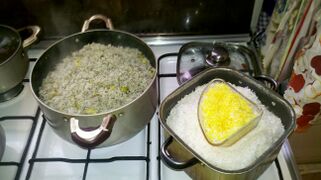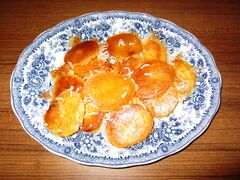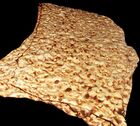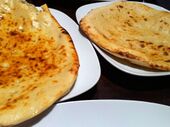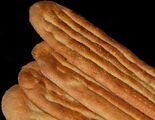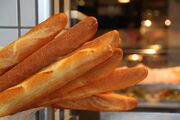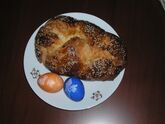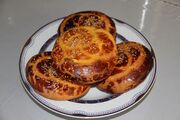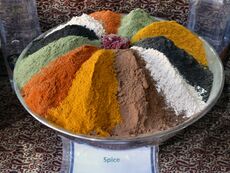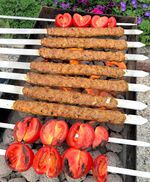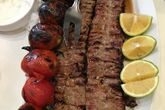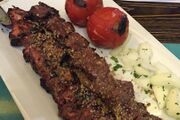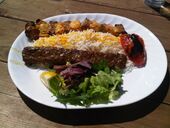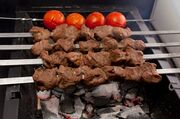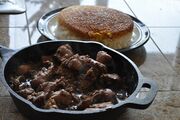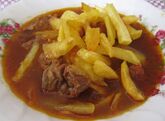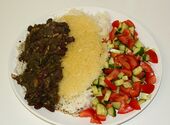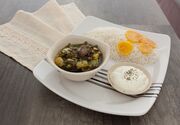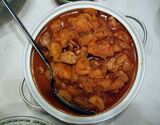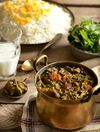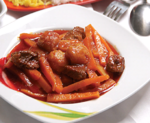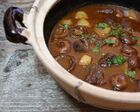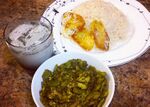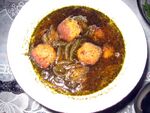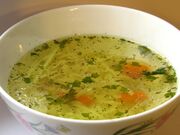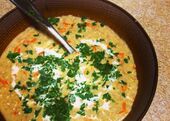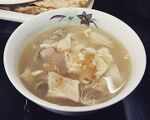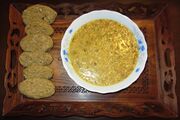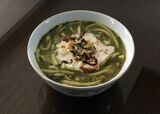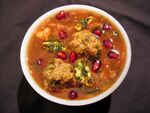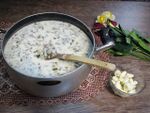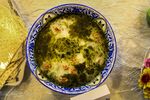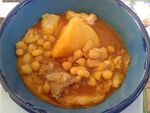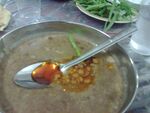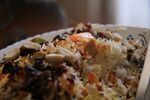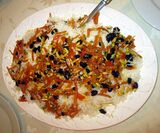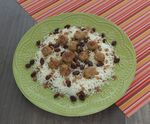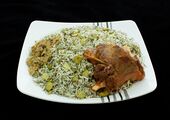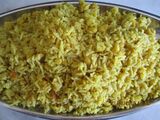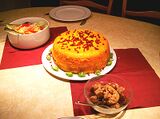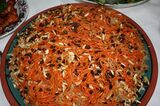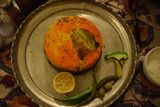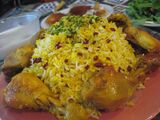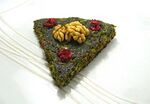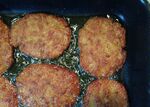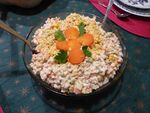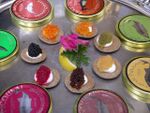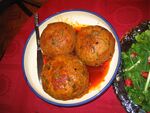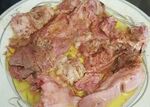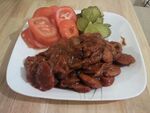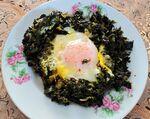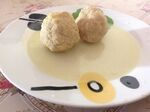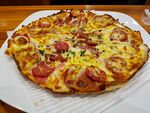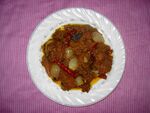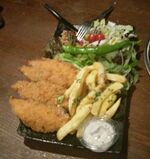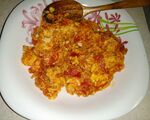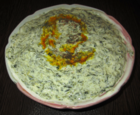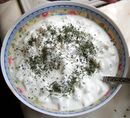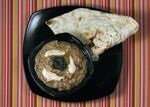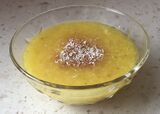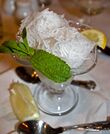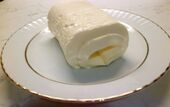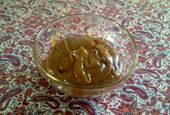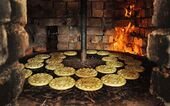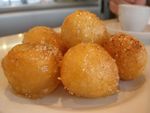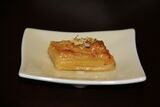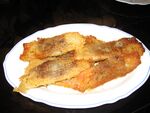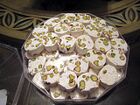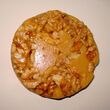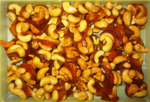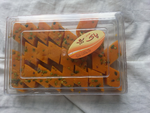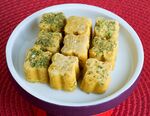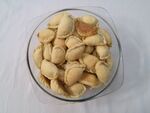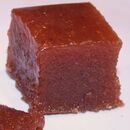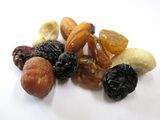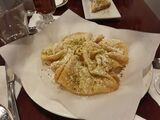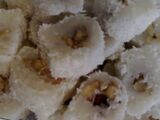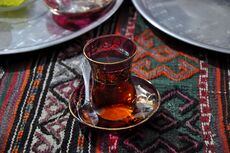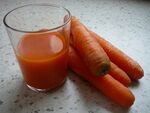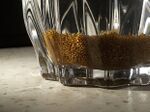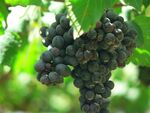المطبخ الفارسي
المطبخ الإيراني Iranian cuisine المطبخ الفارسي تشتهر أكلاته خارج حدود الإمبراطورية الفارسية سابقا
غالبية الأكلات بباكستان والهند والعراق مشتقة من المطبخ الفارسي
المطبخ الفارسي أو الإيراني عريق ومتنوع إذ أن لكل إقليم تقاليده الطهوية الخاصة به والذي يختلف بشكل أساسي عن أسلوب الطهي لمنطقة أخرى في المقاطعة نفسها. ويشتمل على تشكيلة متنوعة من الأطعمة مثل الكباب (بارغ، كوبيده، جوجيه، شيشليك، سلطاني وشينجه) ويخنة خوريشت (والتي هي يخنة تقدم مع الأرز البسمتي أو الإيراني ومنها غورمة سابزي، غيميه) وحساء الأش (أشينار) وكعك الخضروات كووكو وأرز پلو(ويمكن أن يكون أرز أبيض أو مضاف إلى اللحوم أو الخضروات أو التوابل ومنها پلو اللوبية، پلو البالو، پلو سابزي، پلو زيريشك، پلو بغالي وغيرها) وأنواع مختلفة من السلطات والفطائر والأشربة المتميزة بكل منطقة إيرانية.
وتستعمل الأعشاب مع الفواكه في الطهي مثل الخوخ، الرمان، السفرجل، المشمش الزبيب. والمأكل الأيرانية الأساسية هي مزيج من الأرز مع اللحوم (مثل لحم الضأن، الدجاج أو السمك) مع البصل، الخضروات، النقولات والأعشاب. وللحصول على تناسق في المذاق، تستعمل المنكهات الفارسية مثل الزعفران، الزيزفون الجاف، الكمون البقدونس.
. . . . . . . . . . . . . . . . . . . . . . . . . . . . . . . . . . . . . . . . . . . . . . . . . . . . . . . . . . . . . . . . . . . . . . . . . . . . . . . . . . . . . . . . . . . . . . . . . . . . . . . . . . . . . . . . . . . . . . . . . . . . . . . . . . . . . . . . . . . . . . . . . . . . . . . . . . . . . . . . . . . . . . . .
الأكلات الأساسية
الأرز
The following table includes three primary methods of cooking rice in Iran.
| Method | Description |
|---|---|
| Polow and chelow | Chelow is plain rice served as an accompaniment to a stew or kebab, while polow is rice mixed with something. They are, however, cooked in the same way. Rice is prepared by soaking in salted water and then boiling it. The parboiled rice (called chelow) is drained and returned to the pot to be steamed. This method results in an exceptionally fluffy rice with the rice grains separated and not sticky. A golden crust called tadig, is created at the bottom of the pot using a thin layer of bread or potato slices. Often, tadig is served plain with only a rice crust. Meat, vegetables, nuts, and fruit are sometimes added in layers or mixed with the chelow and then steamed. When chelow is in the pot, the heat is reduced and a thick cloth or towel is placed under the pot lid to absorb excess steam. |
| Kateh | Rice that is cooked until the water is absorbed completely. It is the traditional dish of Gilan Province. |
| Dami | Rice that is cooked almost the same as kateh, but at the start, ingredients that can be cooked thoroughly with the rice (such as grains and beans) are added. While making kateh, the heat is reduced to a minimum until the rice and other ingredients are almost cooked. If kept long enough on the stove without burning and over-cooking, dami and kateh can also produce tadig. A special form of dami is tachin, which is a mixture of yogurt, chicken (or lamb), and rice, plus saffron and egg yolks. |
الخبز
Second, only to rice is the production and use of wheat. The following table lists several forms of flatbread and pastry-bread commonly used in Iranian cuisine.
| Lavash: Thin, flaky, and round or oval. It is the most common bread in Iran and the Caucasus. | Sangak: Plain, rectangular, or triangle-shaped leavened flatbread that is stone-baked. | Taftun: Thin, soft and round-shaped leavened flatbread that is thicker than lavash. | Qandi bread: A sweet bread, sometimes brioche-like and sometimes flat and dry.[1] | Barbari: Thick and oval flatbread; also known as Tabrizi, referring to the city of Tabriz. |
| Baguette: A long, narrow French loaf, typically filled with sausages and vegetables. | Sheermal ("milk-rubbed"): A sweet pastry-bread, also widely known as nan-e gisou | Komaj: A sweet date bread with turmeric and cumin, similar to nan e gisu.[2] |
Fruits and vegetables
Agriculture of Iran produces many fruits and vegetables. Thus, a bowl of fresh fruit is common on Iranian tables, and vegetables are standard sides to most meals. These are not only enjoyed fresh and ripe as desserts but are also combined with meat and form accompaniments to main dishes.[3] When fresh fruits are not available, a large variety of dried fruits such as dates, fig, apricots, plum and peach are used instead. Southern Iran is one of the world's major date producers, where some special cultivars such as the Bam date are grown.
Vegetables such as pumpkins, spinach, green beans, fava beans, courgette, varieties of squash, onion, garlic and carrot are commonly used in Iranian dishes. Tomatoes, cucumbers and scallion often accompany a meal. While the eggplant is "the potato of Iran",[4] Iranians are fond of fresh green salads dressed with olive oil, lemon juice, salt, chili, and garlic.
Fruit dolma is probably a specialty of Iranian cuisine. The fruit is first cooked, then stuffed with meat, seasonings, and sometimes tomato sauce. The dolma is then simmered in meat broth or a sweet-and-sour sauce.[5]
Verjuice, a highly acidic juice made by pressing unripe grapes or other sour fruit, is used in various Iranian dishes.[6] It is mainly used within soup and stew dishes, but also to simmer a type of squash dolma. Unripe grapes are also used whole in some dishes such as khoresh e qure (lamb stew with sour grapes). As a spice, verjuice powder (pudr e qure) is sometimes reinforced by verjuice and then dried.
Typical spices

Advieh or chāshni refers to a wide variety of pungent vegetables and dried fruits that are used in Iranian cuisine to flavor food.
One of the traditional and most widespread Iranian spices is saffron, derived from the flower of Crocus sativus. Rose water, a flavored water made by steeping rose petals in water, is also a traditional and common ingredient in many Iranian dishes.
Persian hogweed (golpar), which grows wild in the humid mountainous regions of Iran, is used as a spice in various Iranian soups and stews. It is also mixed with vinegar into which broad beans are dipped before eating.
Some other common spices are cardamom—made from the seeds of several Elettaria and Amomum plants, shevid—an annual herb in the celery family Apiaceae, mahleb—an aromatic spice made from the seeds of Prunus mahaleb, and limu amani—dried lime.
There are also several traditional combinations of spices, two of which are arde—made from toasted ground hulled sesame seeds, and delal sauce—made of heavy salted fresh herbs such as cilantro and parsley.
Typical food and drinks
Typical Iranian cuisine includes a wide variety of dishes, including several forms of kebab, stew, soup, and pilaf dishes, as well as various salads, desserts, pastries, and drinks.
Main course
. . . . . . . . . . . . . . . . . . . . . . . . . . . . . . . . . . . . . . . . . . . . . . . . . . . . . . . . . . . . . . . . . . . . . . . . . . . . . . . . . . . . . . . . . . . . . . . . . . . . . . . . . . . . . . . . . . . . . . . . . . . . . . . . . . . . . . . . . . . . . . . . . . . . . . . . . . . . . . . . . . . . . . . .
Kebab
In Iran, kebabs are served either with rice or with bread. A dish of chelow white rice with kebab is called chelow kabab, which is considered the national dish of Iran. The rice can also be prepared using the kateh method, and hence the dish would be called kateh kabab.
The following table lists several forms of kebab used in Iranian cuisine.
| Kabab koobideh: Barbecued ground lamb or beef, mixed with parsley and onion. | Juje kabab: Grilled chunks of chicken; one of the most common dishes in Iran.[7] | Kabab barg: Barbecued and marinated lamb, chicken or beef. |
| Kabab torsh: Traditional kebab from Gilan and Mazenderan, marinated in a paste of crushed walnuts, pomegranate juice, and olive oil. | Kabab Bakhtyari: Mixture of barbecued fillet of lamb (or veal) and chicken breast.[8] | Chenje: Skewered and grilled cubes of meat. Iranian equivalent of shish kebab.[9] |
| Shashlik: A popular form of shish kebab. In Iranian cuisine, shashlik is usually in form of large chunks. | Kabab tabei: Homemade grilled meat, prepared on the pan.[10] | Bonab kabab: A type of kebab that is made of ground mutton, onion, and salt in the city of Bonab. |
Stew
Khoresh is an Iranian form of stew, which is usually accompanied by a plate of white rice. A khoresh typically consists of herbs, fruits, and meat pieces, flavored with tomato paste, saffron, and pomegranate juice. Other non-khoresh types of stew such as dizi are accompanied by bread instead of rice.
Several Iranian stew dishes are listed within the following table.
| Khoresh e bademjan: Eggplant stew with tomato, Verjuice and saffron. | Khoresh e fesenjan: Stew flavored with pomegranate syrup and ground walnuts. | Khoresh e qeyme: Stew with split peas, French fries, and dried lime. | Qorme sabzi: Stew with herbs such as parsley, leek, cilantro, and fenugreek. |
| Khoresh e karafs: Stewed celery and meat.[11] | Khoresh e alu: Stewed prunes and meat.[12] | Khoresh e alu-esfenaj: Stewed prunes, spinach, and meat.[13][14] | Khoresh e havij: Stewed carrots and meat.[15] |
| Khoresh e qarch: Mushroom stew.[16] | Baqala qatoq: Gilak stew with fava bean, dill, and eggs. | Dizi (piti): Mutton stew with chickpeas and potatoes. | Kufte rize: Azerbaijani and Kurdish meatball stew. |
Soup and āsh
There are various forms of soup in Iranian cuisine, including sup e jow ("barley soup"), sup e esfenaj ("spinach soup"), sup e qarch ("mushroom soup"), and several forms of "thick soup". A thick soup is referred to as āsh in Iran, which is an Iranian traditional form of soup.[17] Also, shole qalamkar is the Iranian term for "Hodge-Podge" soup,[18] a soup made of a mixture of various ingredients.
The following table lists a number of soup and āsh dishes in Iranian cuisine.
| Sup e morgh: Chicken and noodle soup.[19] | Sup e jow: Barley soup.[20] | Sirabi: Tripe soup; also known as sirab shirdun.[21] |
| Tarkhine: Grain and yoghurt soup. | Gazane: Nettle soup. | Adasi: Lentil soup. |
| Āsh e reshte: Noodle thick soup. | Āsh e anār: Pomegranate thick soup. | Āsh e doogh: Buttermilk thick soup. |
| Kalle Joosh: Kashk thick soup. | Bozbash: meat soup with red or white beans, green vegetables, herbs, onions and leeks, dried limes and spices. | Shole: Thick soup with meat, different Legume, wheat Bulgur, rice, Nutmeg and other Spices. Shole is originally from Mashhad. |
. . . . . . . . . . . . . . . . . . . . . . . . . . . . . . . . . . . . . . . . . . . . . . . . . . . . . . . . . . . . . . . . . . . . . . . . . . . . . . . . . . . . . . . . . . . . . . . . . . . . . . . . . . . . . . . . . . . . . . . . . . . . . . . . . . . . . . . . . . . . . . . . . . . . . . . . . . . . . . . . . . . . . . . .
Polow and dami
Apart from dishes of rice with kebab or stew, there are various rice-based Iranian dishes cooked in the traditional methods of polow and dami.
Polow is the Persian word for pilaf and it is also used in other Iranian languages, in the English language it may have variations in spelling. A polow dish includes rice stuffed with cuts of vegetables, fruits, and beans, usually accompanied by either chicken or red meat. Dami dishes are similar to polow in that they involve various ingredients with rice, however they are cooked using the dami method of cooking the dish all in one pot.
The following are a number of traditional Iranian rice-based dishes:
| Sabzi polow: Rice with chopped herbs, usually served with fish. | Lubia polow: Rice with green beans and minced meat. | Albalu polow: Rice with sour cherries and slices of chicken or red meat. | Morasa polow: Rice "jewelled" with barberries, pistachios, raisins, carrots, orange peel, and almonds.[22][23] |
| Shirin polow: Rice with sweet carrots, raisins, and almonds.[24] | Adas polow: Rice with lentils, raisins, and dates.[25] | Baqali polow: Rice with fava beans and dill weed.[26] | Dampokhtak: Turmeric rice with lima beans.[27] |
| Tachin: Rice cake including yogurt, egg, and chicken fillets. | Quabili polow: Rice with raisins, carrots and Beef or lamb. | Kalam Polow: Rice with cabbage and different herbs. | Zereshk Polow: Rice with berberis and saffron. |
Other
| Kuku: Whipped eggs folded in with herbs or potato. | Kotlet: Mixture of fried ground beef, mashed potato, and onion. | Olivier salad: Mixture of potato, eggs, peas, and diced chicken (or sausage), dressed with mayonnaise. | Caviar: Salt-cured fish eggs. |
| Dolme: Stuffed peppers or vine leaves. | Kufte: Meatball or meatloaf dishes. | Zaban: Beef tongue. | Pache: Boiled parts of cow or sheep; also known as khash. |
| Pirashki (pirozhki): Baked or fried buns stuffed with a variety of fillings. | Sosis bandari: Traditional sausage with onion, tomato paste, and chili pepper. | Nargesi: A type of spinach omelette. | Sirabij: A type of garlic omelette. |
| Gondi: Iranian Jewish dish of meatball. | Iranian pizza: A typical Iranian pizza. | Dopiaza: Traditional Shiraz curry prepared with a large quantity of onions. | Joshpara: Azerbaijani meat-filled dumplings. |
| Shenitsel: Fried breaded meat. | Tomato scrambled eggs: A dish made from eggs and tomato. | Jaqur-Baqur: A dish made from sheep's heart, liver and kidney. | Biryan: A traditional dish in Isfahan made from minced meat, fat, onion, cinnamon, saffron, walnut and mint that is served with baked lung. |
Appetizers
| Torshi: Mixed pickles salad. | Salad Shirazi: Chopped cucumbers, tomato, and onion with verjuice and a little lemon juice. | Borani: Yogurt with spinach and other ingredients. | Mast o khiar: Strained yogurt with cucumber, garlic, and mint. |
| Sabzi (greens): Fresh herbs and raw vegetables. | Zeytun parvarde: Olives in a paste made of pomegranate, walnut and garlic.[28] | Mirza Qasemi: Grilled eggplant with egg, garlic and tomato. | Kashk e bademjan: Mixture of kashk, eggplant and mint. |
Desserts
In 400 BC, the ancient Iranians invented a special chilled food, made of rose water and vermicelli, which was served to royalty in summertime.[29] The ice was mixed with saffron, fruits, and various other flavors. Today, one of the most famous Iranian desserts in the semi-frozen noodle dessert known as faloodeh, which has its roots in the city of Shiraz, a former capital of the country.[30][31] Bastani e zaferani, Persian for "saffron ice cream", is a traditional Iranian ice cream which is also commonly referred to as "the traditional ice cream". Other typical Iranian desserts include several forms of rice, wheat and dairy desserts.
The following is a list of several Iranian desserts.
| Fereni: Sweet rice pudding flavored with rose water.[32] | Sholezard: Saffron rice-based dessert. | Halva: Wheat flour and butter, flavored with rose water. | Bastani e zaferani: Saffron ice cream. |
| Faloodeh: Vermicelli mixed in a semi-frozen syrup of sugar and rose water. | Sarshir: Creamy dairy product similar to clotted cream. | Samanu: Germinated wheat, typically served for Nowruz. |
Snacks
Cookies appear to have their origins in 7th-century Iran, shortly after the use of sugar became relatively common in the region.[33] There are numerous traditional native and adopted types of snack food in modern Iran, of which some are listed within the following table.
| Koluche: Cookies, with major production in Fuman and Lahijan. | Bamie: Deep fried dough soaked in sugar syrup. | Baqlava: Pastry made of filo, nuts, and sugar syrup. | Reshte khoshkar: Fried and spiced rice flour and walnut. |
| Nougat and gaz: Made of sugar, nuts, and egg white. | Sohan: Saffron brittle candy with nuts. | Sohan asali: Brittle candy with honey. | Nan-e berenji: Rice flour cookies.[34] |
| Tabrizi Lovuez: Diamond-shaped, made of almond powder, sugar, and saffron. | Nokhodchi: Chickpea cookies.[35] | Qottab: Almond-filled deep-fried pastry. | Kolompe: Pie made of dates and cardamom. |
| Nabat chubi: Rock candy, commonly flavored with saffron in Iran. | Pashmak: Cotton candy. | Trail mix: Dried fruit, grains, and nuts. | Quince cheese: Made of quince and sugar. |
| Ajil e Moshkel-gosha: Traditional packed trail mix for Nowruz. | Gush e fil: Dough topped with pistachios powdered sugar. | Poolaki: Thin candy made of sugar, water, and white vinegar. | Baslogh: Pastry made of grape syrup, starch and almond.[36] |
Drinks
Iran is one of the world's major tea producers,[37][بحاجة لمصدر أفضل] mostly cultivated in its northern regions. In Iranian culture, tea (čāy) is widely consumed[38][39] and is typically the first thing offered to a guest.[40] Iranians traditionally put a lump of sugar cube in the mouth before drinking the tea.[41] Rock candies are also widely used, typically flavored with saffron.
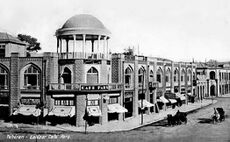
Iran's traditional coffee (qahve, or kāfe) is served strong, sweet, and "booby-trapped with a sediment of grounds".[42] In 16th-century Safavid Iran, coffee was initially used for medical purposes among the society.[43] Traditional coffeehouses were popular gatherings, in which people drank coffee, smoked tobacco, and recited poetry—especially the epic poems of Shahnameh.[44] In present-day Iran, cafés are trendy mostly in urban areas, where a variety of brews and desserts are served.[42] Turkish coffee is also popular in Iran, more specifically among Iranian Azeris.[45][46]
Wine (mey) has also a significant presence in Iranian culture. Shirazi wine is Iran's historically most famous wine production, originating from the city of Shiraz.[47][48][49] By the 9th century, the city of Shiraz had already established a reputation for producing the finest wine in the world,[48] and was Iran's wine capital. Since the 1979 Revolution, alcoholic beverages have been prohibited in Iran; though non-Muslim recognized minorities (i.e. Christians, Jews, and Zoroastrians) are allowed to produce alcoholic beverages for their own use.[50] While non-alcoholic beer (ābjow) is available from legal outlets, other citizens prepare their alcoholic beverages illegally through the minority groups[51][52][53] and largely from Iraqi Kurdistan and Turkey.[54]
Araq sagi, literally meaning "doggy distillate", is a type of distilled alcoholic beverage in Iran which contains at least 65% pure ethanol. It is usually produced at homes from raisins, and is similar to Turkish rakı.[55] Prior to the 1979 Revolution, it had been produced traditionally in several cities of Iran. Since it was outlawed following the 1979 Revolution, it has become a black market and underground business.
The following table lists several Iranian cold beverages.
| Doogh: Cold yogurt drink. | Pomegranate juice | Carrot juice,[56] sometimes mixed with ice cream.[57] | Khakshir: Cold sweet drink with Descurainia sophia seeds.[58] |
| Sekanjebin: Cold drink made of honey and vinegar. | Aragh sagi: A type of distilled alcoholic beverage. | Sharbat: Cold and sweet drink made of fruits or flower petals. | Shiraz wine: Wine produced from Shiraz grapes around the city of Shiraz in Iran. |
Regional Iranian cuisine
Azerbaijani cuisine
The Azerbaijani people, living primarily in the region of Azerbaijan in northwestern Iran, have a number of local dishes that include Bonab kabab (Binab kababı),[59] the dumpling dish of joshpara (düşbərə), a dish identical to the Scottish haggis that is called jaqur-baqur,[60] a variety of āsh called kələcoş,[61] a variation of qeyme that is called pıçaq, and a variation of kufte that is called Tabriz meatballs. There is also the traditional pastry of shekerbura (şəkərbura), which is identical to Khorasan's shekarpare (šekarpāre). Despite the influences from Turkey, the food tastes noticeably Iranian, though also with its own unique features, such as using more lemon juice and butter than other groups of Iranians.[62]
Balochi cuisine
Meat and dates are the main ingredients in the cuisine of Iran's southeastern region of Baluchistan.[63][64] Rice is primarily cultivated in the region of Makran.[63][64] Foods that are specific to the Iranian region of Baluchistan include tanurche (tarōnča; tanurče), a local variety of grilled meat that is prepared in a tanur, doogh-pa (dōq-pâ), a type of khoresh that contains doogh, and tabahag (tabâhag), that is meat prepared with pomegranate powder.[63][64] Baluchi cuisine also includes several date-based dishes, as well as various types of bread.[63][64]
Caspian cuisine
The southern coast of the Caspian Sea, which consists of the Iranian provinces of Gilan, Mazanderan, Alborz, and Golestan, has a fertile environment that is also reflected in its cuisine.[65][66] Kateh is a method of cooking rice that originates from this region.[67] This type of rice dish is also eaten there as a breakfast meal, either heated with milk and jam or cold with cheese and garlic. Caviar fish roes also hail from this region, and are typically served with eggs in frittatas and omelettes. Local cookies (koluče) of the region are also popular.[66]
Kurdish cuisine
The region of Kurdistan in western Iran is home to a variety of local āsh, pilaf, and stew dishes.[68] Some local Kurdish dishes include a traditional grilled rib meat that is called dande kabāb,[69] a type of khoresh made of chives that is called xoreš-e tare,[70] and a dish of rice and potatoes that is called sib polow.[71]
Southern Iranian cuisine
The food of southern Iran is typically spicy.[72] Mahyawa is a tangy sauce made of fermented fish in this region.[بحاجة لمصدر] Being a coastal region, Khuzestan's cuisine includes especially seafood, as well as some unique local beverages.[73] In southern Khuzestan, there is also a variation of kufte that is known as kibbeh and is made of ground meat, cracked wheat, different types of herbs and vegetables and various spices.
Turkmen cuisine
Iran's Turkmen people are predominantly centered in the Iranian provinces of Golestan and North Khorasan. Chegderme (čekderme) is a Turkmen dish made of rice, meat, and tomato paste.[74]
Structure
Meals
Breakfast
The basic traditional Iranian breakfast consists of a variety of flat breads, butter cubes, white cheese, whipped heavy cream (sarshir; often sweetened with honey), nuts (especially walnuts) and a variety of fruit jams and spreads.
Many cities and towns across Iran feature their own distinct versions of breakfast dishes. Pache, a popular traditional dish widely eaten in Iran and the neighboring Caucasus, is almost always only served from three in the morning until sometime after dawn, and specialty restaurants (serving only pache) are only open during those hours.
Lunch and dinner
Traditional Iranian cooking is done in stages, at times needing hours of preparation and attention. The outcome is a well-balanced mixture of herbs, meat, beans, dairy products, and vegetables. Major staples of Iranian food that are usually eaten with every meal include rice, various herbs, cheese, a variety of flat breads, and some type of meat (usually poultry, beef, lamb, or fish). Stew over rice is by far the most popular dish, and the constitution of these vary by region.
Traditional table setting and etiquette
Traditional Iranian table setting firstly involves the tablecloth, called sofre, and is spread out over either a table or a rug. Main dishes are concentrated in the middle, surrounded by smaller dishes containing appetizers, condiments, and side dishes, all of which are nearest to the diners. When the food is perfectly served, an invitation is made to seat at the sofre and start having the meal.
انظر أيضاً
- List of Iranian foods
- Mazanderani cuisine
- Kurdish cuisine
- Azerbaijani cuisine
- Agriculture in Iran
- Nimatnama-i-Nasiruddin-Shahi, a medieval Indian Persian language cookbook.
ملاحظات
المراجع
- ^ Davidson, Alan. Jaine, Tom. (2014). The Oxford Companion to Food. p. 414. ISBN 9780199677337.
{{cite book}}: CS1 maint: multiple names: authors list (link) - ^ Tales of a Kitchen (March 5, 2013). "Persian date bread with turmeric and cumin (Komaj)".
- ^ Ramazani, Nesta. "Uses of the Fruit in Cooking". Encyclopedia Iranica. Retrieved 2008-10-11.
- ^ "Production/Crops for Eggplant in 2013". Food and Agriculture Organization of the United Nations, Statistics Division (FAOSTAT). 2015. Retrieved 20 November 2015.
- ^ Ghanoonparvar, M. R. "Dolma". Encyclopedia Iranica. Retrieved 2009-04-05.
- ^ Ramazani, N. "ĀB-ḠŪRA". Encyclopedia Iranica. Retrieved 2011-06-26.
- ^ "Saffron and lemon chicken (Joojeh Kabab)". Irish Times (in الإنجليزية الأمريكية). Retrieved 2016-07-02.
- ^ Burke, Andrew. Elliott, Mark. (15 September 2010). "MAIN COURSES: Kabab". Iran. Ediz. Inglese. p. 84. ISBN 9781742203492.
{{cite book}}: CS1 maint: multiple names: authors list (link) - ^ Sally Butcher (Oct 10, 2013). "Kebab-e-Chenjeh". Snackistan. ISBN 9781909815155.
- ^ Aashpazi.com. "KABAB TABEI".
- ^ Vatandoust, Soraya. (13 March 2015). "Khoresh-e Karafs". Authentic Iran: Modern Presentation of Ancient Recipes. p. 132. ISBN 9781499040616.
- ^ Ramazani, Nesta. (1997). "Khoresht-e aloo". Persian Cooking: A Table of Exotic Delights. p. 138. ISBN 9780936347776.
- ^ Dana-Haeri, Jila. Lowe, Jason. Ghorashian, Shahrzad. (28 February 2011). "Glossary". New Persian Cooking: A Fresh Approach to the Classic Cuisine of Iran. p. 221. ISBN 9780857719553.
{{cite book}}: CS1 maint: multiple names: authors list (link) - ^ Goldstein, Joyce. (12 April 2016). "Persian Stew with Lamb or Beef, Spinach, and Prunes". The New Mediterranean Jewish Table: Old World Recipes for the Modern Home. p. 319. ISBN 9780520960619.
- ^ Ramazani, Nesta. (1997). Persian Cooking: A Table of Exotic Delights. p. 130. ISBN 9780936347776.
- ^ Dana-Haeri, Jila. Ghorashian, Shahrzad. Lowe, Jason. (28 February 2011). "Khoresht-e gharch". New Persian Cooking: A Fresh Approach to the Classic Cuisine of Iran. p. 72. ISBN 9780857719553.
{{cite book}}: CS1 maint: multiple names: authors list (link) - ^ Elāhī, ʿE. "ĀŠ (thick soup), the general term for a traditional Iranian dish comparable to the French potage.". Encyclopedia Iranica. Retrieved 2016-02-08.
- ^ Trost, Alex. Kravetsky, Vadim. (13 June 2014). 100 of the Most Delicious Iranian Dishes. p. 8. ISBN 9781494498092.
{{cite book}}: CS1 maint: multiple names: authors list (link) - ^ Ramazani, Nesta. (1997). "Chicken Soup (Soup-e Morgh)". Persian Cooking: A Table of Exotic Delights. p. 38. ISBN 9780936347776.
- ^ Vatandoust, Soraya. (13 March 2015). "Soup-e Jow". Authentic Iran: Modern Presentation of Ancient Recipes. p. 22. ISBN 9781499040616.
- ^ Meftahi, Ida. (14 July 2017). Gender and Dance in Modern Iran: Biopolitics on Stage. p. 72. ISBN 9781317620624.
sirabi-va-shirdun
- ^ Shafia, Louisa. (16 April 2013). "Morasa polo". The New Persian Kitchen. ISBN 9781607743576.
- ^ "Jeweled Rice (Morasa Polo)". Parisa's Kitchen. October 9, 2014.
- ^ Daniel, Elton L. Mahdī, ʻAlī Akbar. (2006). Culture and Customs of Iran. p. 153. ISBN 9780313320538.
{{cite book}}: CS1 maint: multiple names: authors list (link) - ^ Batmanglij, Najmieh. (2007). "Adas polow". A Taste of Persia: An Introduction to Persian Cooking. p. 96. ISBN 9781845114374.
- ^ Batmanglij, Najmieh. (2007). "Baqala polow". A Taste of Persia: An Introduction to Persian Cooking. p. 104. ISBN 9781845114374.
- ^ Batmanglij, Najmieh. (1990). Food of Life: A Book of Ancient Persian and Modern Iranian Cooking and Ceremonies. p. 103. ISBN 9780934211277.
- ^ Vatandoust, Soraya. (13 March 2015). "Zeytoon Parvardeh". Authentic Iran: Modern Presentation of Ancient Recipes. p. 44. ISBN 9781499040616.
- ^ "History of Ice Cream". thenibble.com.
- ^ "Shiraz Sights" Archived 2016-07-18 at the Wayback Machine, at BestIranTravel.com
- ^ Marks, Gil (2010-11-17). Encyclopedia of Jewish Food (in الإنجليزية). Wiley. ISBN 9780470943540.
- ^ Vatandoust, Soraya. (13 March 2015). "Chapter 8". Authentic Iran: Modern Presentation of Ancient Recipes. p. 186. ISBN 9781499040616.
- ^ "History of Cookies - Cookie History". Whatscookingamerica.net. Retrieved 2015-02-27.
- ^ Ramazani, Nesta. (1997). "Rice Flour Cookies (Nan-e Berenji)". Persian Cooking: A Table of Exotic Delights. p. 227. ISBN 9780936347776.
- ^ Marks, Gil. (17 November 2010). "Shirini". Encyclopedia of Jewish Food. ISBN 9780544186316.
- ^ Butcher, Sally. (18 November 2012). "Peckham Delight". Veggiestan: A Vegetable Lover's Tour of the Middle East. ISBN 9781909108226.
- ^ Food and Agriculture Organization of the United Nations—Production FAOSTAT. Retrieved 30 April 2010.
- ^ Williams, Stuart. (October 2008). "DRINKING". Iran - Culture Smart!: The Essential Guide to Customs & Culture. ISBN 9781857335989.
Iranians are obsessive tea drinkers
- ^ Maslin, Jamie. (13 October 2009). Iranian Rappers and Persian Porn: A Hitchhiker's Adventures in the New Iran. p. 58. ISBN 9781602397910.
Iran is a nation of obsessive tea drinkers
- ^ Burke, Andrew; Elliott, Mark; Mohammadi, Kamin & Yale, Pat (2004). Iran. Lonely Planet. pp. 75–76. ISBN 1-74059-425-8.
Iranian guest tea.
- ^ Edelstein, Sari. (2011). Food, Cuisine, and Cultural Competency for Culinary, Hospitality, and Nutrition Professionals. p. 595. ISBN 9780763759650.
Tea is usually sweetened with lumps of sugar. Most Iranians sip their tea through these lumps of sugar by placing the lump inside their cheek
- ^ أ ب Burke, Andrew. Elliott, Mark. (15 September 2010). "Coffee". Iran. Ediz. Inglese. p. 81. ISBN 9781742203492.
{{cite book}}: CS1 maint: multiple names: authors list (link) - ^ Matthee, Rudolph P. (2005). The Pursuit of Pleasure: Drugs and Stimulants in Iranian History, 1500-1900. p. 146. ISBN 0691118558.
- ^ Newman, Andrew J. (31 March 2006). Safavid Iran: Rebirth of a Persian Empire. p. 96. ISBN 9781860646676.
- ^ "Getting Your Buzz with Turkish coffee". ricksteves.com. Retrieved 19 August 2015.
- ^ Brad Cohen. "BBC - Travel - The complicated culture of Bosnian coffee". bbc.com. Retrieved 19 August 2015.
- ^ Marjolein Muys (1 April 2010). Substance Use Among Migrants: The Case of Iranians in Belgium. Asp / Vubpress / Upa. pp. 78–. ISBN 978-90-5487-564-2.
- ^ أ ب Entry on "Persia" in J. Robinson (ed), "The Oxford Companion to Wine", Third Edition, p. 512-513, Oxford University Press 2006, ISBN 0-19-860990-6
- ^ Hugh Johnson, "The Story of Wine", New Illustrated Edition, p. 58 & p. 131, Mitchell Beazley 2004, ISBN 1-84000-972-1
- ^ Edelstein, Sari. (2011). Food, Cuisine, and Cultural Competency for Culinary, Hospitality, and Nutrition Professionals. p. 595. ISBN 9780763759650.
Since the Islamic Revolution of 1979, alcoholic beverages have been strictly banned...non-Muslim minority groups...are entitled to produce wine for their own consumption.
- ^ Afshin Molavi (12 July 2010). The Soul of Iran: A Nation's Struggle for Freedom. W. W. Norton. pp. 95–. ISBN 978-0-393-07875-6.
- ^ A. Christian Van Gorder (2010). Christianity in Persia and the Status of Non-muslims in Iran. Rowman & Littlefield. pp. 195–. ISBN 978-0-7391-3609-6.
- ^ Kevin Boyle; Juliet Sheen (7 March 2013). Freedom of Religion and Belief: A World Report. Routledge. pp. 423–. ISBN 978-1-134-72229-7.
- ^ Saeed Kamali Dehghan (25 June 2012). "Iranian pair face death penalty after third alcohol offence | World news". The Guardian. London. Retrieved 2013-06-11.
- ^ Abdulah Skaljic (1985). Turcizmi u srpskohrvatskom-hrvatskosrpskom jeziku. Sarajevo.
{{cite book}}: CS1 maint: location missing publisher (link) - ^ Edelstein, Sari. (2011). Food, Cuisine, and Cultural Competency for Culinary, Hospitality, and Nutrition Professionals. p. 595. ISBN 9780763759650.
aab-e havij, a carrot juice
- ^ Duguid, Naomi. (6 September 2016). Taste of Persia: A Cook's Travels Through Armenia, Azerbaijan, Georgia, Iran, and Kurdistan. p. 353. ISBN 9781579657277.
...havij bastani, a kind of ice cream float, made with Persian ice cream and carrot juice
- ^ J. & A. Churchill. (1878). The Pharmaceutical Journal and Transactions, Volume 37. p. 385.
Khakshir is imported from Persia...
- ^ "کباب بناب از کجا آمده است؟" [Where has Bonab kebab come from?]. Khabaronline News Agency (in الفارسية). March 5, 2011.
- ^ "طرز تهیه جغول بغول" [Method of preparing Jaqul Baqul]. Tabnak News (in الفارسية). February 14, 2018.
- ^ "آشنایی با غذاهای خوشمزه چهار گوشه ایران" [Getting to know delicious foods from the four corners of Iran]. Hamshahri (in الفارسية). March 27, 2013.
- ^ Collinson, Paul; Macbeth, Helen (2014). Food in Zones of Conflict: Cross-Disciplinary Perspectives. Berghahn Books. p. 178. ISBN 9781782384038.
- ^ أ ب ت ث "بفرمایید غذاهای بلوچی" [Check out Baluchi foods]. Jam-e-Jam Online (in الفارسية). May 18, 2013.
- ^ أ ب ت ث "غذاهای سنتی سیستان و بلوچستان ریشه در باور و طبیعت دارد" [The traditional foods of Sistan and Baluchistan are rooted in belief and nature]. Mehr News (in الفارسية). March 14, 2016.
- ^ Burke, Andrew; Maxwell, Virginia (2012). Lonely Planet Iran. ISBN 978-1743213209.
- ^ أ ب "A foodie tour of Iran: it's poetry on a plate". The Guardian. October 29, 2016.
- ^ Batmanglij, Najmieh (2007). A Taste of Persia: An Introduction to Persian Cooking. I.B.Tauris. p. 87. ISBN 9781845114374.
- ^ "خوراک جشن دندان" [Tooth celebration food]. Hamshahri (in الفارسية). August 20, 2017.
- ^ "دنده کباب' کرمانشاه ثبت ملی میشود'" ["Kermanshah's 'dande kebab' gets national registration"]. ISNA (in الفارسية). October 15, 2016.
- ^ "آشنایی با روش تهیه خورش تره، غذای کردی" [Introduction to the method of preparing chives khoresh, a Kurdish food]. Hamshahri (in الفارسية). June 15, 2013.
- ^ "سیب پلو" [Apple Pilaf]. IRIB - Isfahan (in الفارسية). Retrieved April 23, 2018.
- ^ "Taste of Persia: 10 foodie ways to see Iran". The Telegraph. April 6, 2016. Archived from the original on 12 January 2022.
The food of southern Iran is hot and spicy, just like its climate (...)
- ^ "Khuzestan boasts assortment in cuisine". Iran Daily (IRNA). December 4, 2015.
- ^ "چکدرمه'، غذای محلی ترکمنها'" ["Chekderme", local food of the Turkmen]. Jam-e-Jam Online (in الفارسية). March 30, 2013.
للاستزادة
- Daniel, Elton L.; Mahdi, Ali Akbar (2006). Culture and Customs of Iran. Greenwood Press. pp. 149–155. ISBN 978-0-313-32053-8.
- "ĀŠPAZĪ" [cooking]. Encyclopaedia Iranica. December 15, 1987.
- Ethnic Fermented Foods and Beverage of Iran. Springer.
{{cite book}}: Cite uses deprecated parameter|authors=(help)
وصلات خارجية
- [%D8%A7%D9%84%D9%85%D8%BA%D9%88%D9%84 الهند تبنّت أساليب الطهي الفارسي شكراً لإمبراطورية المغول]
- CS1 الإنجليزية الأمريكية-language sources (en-us)
- CS1 maint: location missing publisher
- CS1 الفارسية-language sources (fa)
- Short description matches Wikidata
- All pages needing factual verification
- Wikipedia articles needing factual verification from January 2020
- Articles with hatnote templates targeting a nonexistent page
- Articles containing آذربيجاني-language text
- Articles with unsourced statements from April 2018
- CS1 errors: deprecated parameters
- Region topic template using suffix
- المطبخ الإيراني
- Cuisine by culture
- Middle Eastern cuisine
- Persian culture
